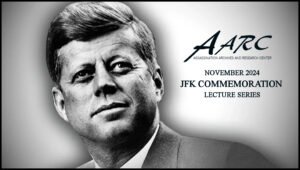 The AARC presents a new series of lectures commemorating and honoring the legacy of President Kennedy, the inspirational meaning of his term of office, and the consequences of his assassination sixty-two years ago.
The AARC presents a new series of lectures commemorating and honoring the legacy of President Kennedy, the inspirational meaning of his term of office, and the consequences of his assassination sixty-two years ago.
In the words of the distinguished British scholar Malcolm Blunt, “Jesus Christ, what we lost when we lost that man.”

John Simkin (BA, MA, MPhil)
While studying at the Open University John Simkin became convinced by the ideas of Jerome Bruner on active learning. Since he began teaching history in 1978 he has attempted to produce materials that enable active learning to take place. This has included educational computer programs such as Attack on the Somme, Wall Street and The Russian Revolution. The internet provides the best opportunity so far to make active learning a reality.
Over the last twenty years he has written several history books including Gandhi (1987), The Vietnam War (1988), Race Relations in the United States (1988), Slavery: An Illustrated History of Black Resistance (1988), Hitler (1988), Stalin (1987), The Roman Empire (1991), Making of the United Kingdom (1992), Expansion, Trade and Industry (1992), The Medieval Village (1996), The Norman Invasion (1996), etc.
In September, 1997, along with Judith Harris Simkin, Mr. Simkin established the Spartacus Educational website and over the next six years produced online material for the Daily Telegraph, the European Virtual School and The Guardian and its educational website, Learn. He was also a member of the European History E-Learning Project (E-Help), a project to encourage and improve use of ICT and the internet in classrooms across the continent. He currently teaches several courses at the University of the Third Age, including Understanding the Modern World: The Romans to the Information Society and History of Ideas.
Mr. Simkin has published ten e-books, Charles Dickens: A Biography (October, 2012), First World War Encyclopedia (October, 2012), Assassination of John F. Kennedy Encyclopedia (November, 2012), Gandhi: A Biography (December, 2012), The Spanish Civil War (December, 2012), The American Civil War (December, 2012), Henry VII (September, 2015), Henry VIII (September, 2015), Anne Boleyn (September, 2015) and Mary Tudor (September, 2015). He is the author of, Using New Technologies to Enhance Teaching and Learning in History (December, 2012), and in September 2015 was one of the historians interviewed for the BBC documentary, The Hollywood Spy.
As of October, 2019, the Spartacus Educational website contained 21,036,905 words and 33,196 sources. Spartacus Educational is committed to producing free content, especially to those countries that find it difficult to purchase books.
You can find a more detailed autobiography here: John Simkin
This what ChatGPT AI said on 26th May 2023:
Spartacus Educational is an educational website that provides a wide range of resources and materials related to history, politics, and social issues. It was created by John Simkin, a former history teacher, and is named after the famous Roman gladiator and rebel leader, Spartacus.
The website offers articles, biographies, and primary source documents on various historical topics, covering a wide range of periods and subjects. It aims to promote critical thinking and provide in-depth information to educators, students, and the general public.
Spartacus Educational covers a diverse range of topics, including world history, wars, revolutions, famous individuals, social movements, and more. The content includes well-researched articles, images, and interactive resources to engage and educate visitors.
The website is known for its emphasis on presenting historical events and figures in a balanced and unbiased manner. It encourages users to explore different perspectives and interpretations, fostering a deeper understanding of complex historical events.
Overall, Spartacus Educational is a valuable resource for anyone seeking reliable and comprehensive information on a wide range of historical topics.
Simkin’s work on Spartacus Educational has garnered recognition and acclaim. His dedication to research and education has made him a respected figure within the history community. While specific personal details about John Simkin may be limited, his contributions to history education through the Spartacus Educational platform have left a lasting impact.
Spartacus Educational is widely recognized as an invaluable online resource. To help keep Spartacus a viable research tool, you can help by doing the following: (1) Do not use ad-blocker. (2) Share Spartacus pages via Twitter, Facebook, etc. (3) Make a small donation or a small monthly subscription.
